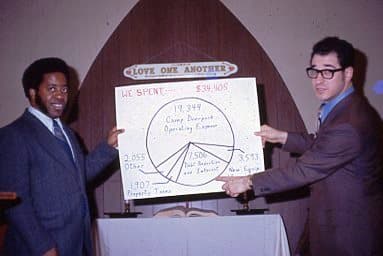The Early Years
Five decades later, early memories of Camp Deerpark remain vivid for many of those who experienced the ministry’s first year.
Wes Newswanger, one of the first camp pastors, remembers the unbridled enthusiasm of New York City children arriving at camp and bee-lining it down the front lawn for the swings and other playground equipment.
Doris Stoltzfus, one of the earliest hosts for camp events, recalls that “I had to learn to clean really fast” and to “become a cook for a large group.”
Volunteer Miriam Buckwalter chuckles in recounting her failed experiment of serving lime Jell-O salad with cottage cheese to young campers. Her husband, John, remembers the “shoe-string” finances that framed so many camp decisions.
And as one of the first children to visit camp, I still remember clearly the bracing sensation of cold mountain water running over my bare feet as I tried, at age 7, to catch slippery salamanders hiding under rocks in the small, flow-through pond that still marks the camp’s main entrance.
On May 6, 1969, New York City Mennonites realized a years-long dream when they finalized their purchase of the former “Brandt’s Pleasant View” farm resort for $85,000, equal to about $572,000 in 2017 dollars.
With the settlement on the 277-acre property, six months after church officials made their offer to purchase it, the idea of a church camp had progressed quickly from a dream to a leap of faith to a call to action.
There was little time to waste. Campers were coming. And the city’s Mennonite congregations—which included Bronx Spanish, First Mennonite of Brooklyn, Fox Street, Glad Tidings, Good Shepherd, House of Friendship and Seventh Avenue—would be eager to check out this new country retreat.
The first official event was held three weeks after the property settlement, when several dozen teenagers traveled to camp for a citywide youth retreat on Memorial Day weekend. Camps for children ages 8 to 12 were held in July, the same month that Glad Tidings held the first congregational retreat.
The learning curve was steep. And there was much work to be done. Early leaders had to figure out how to plan, promote, implement and operate a Christian camping program, and how to fund it with meager resources.“There was no budget,” recalled Dale Stoltzfus, the first camp coordinator, who made many purchases of bulk canned goods in an effort to keep food on the camp table.
There was also work to do to the property itself, and infinite details to take care of. One early project involved converting what had been known as “the casino” to a chapel. Among the items cleaned out: a bar, a jukebox,12 beer mugs, 38 highball glasses and a bowling machine (part of which was used in a tree fort that a trio of young boys later built in the woods).Camp Deerpark’s electric bill said “Casino” until five years ago when Barb Freeman had it changed.
As summer turned to fall, Dale Stoltzfus purchased 200 “No Trespassing” signs to put up before the fall hunting season.
By early October, five months after settlement on the property, the camp had functioned on a mere $8,270 in operational income, according to meeting minutes. Revenue included $4,561 from children’s camps, $3,091 from group use, $247 from rentals of the motel rooms and $371 from refreshment sales. Donations and membership fees, including those from churches, provided additional income.

Seventh Avenue Mennonite Church.
Spending was similarly modest. Food costs for the first five months of operations totaled$2,877. Insurance cost 8 cents per camper per day.
By November and December, plans were well underway for the second year. A camp brochure was being designed, a riding mower was donated, tickets for a Pennsylvania fund-raising banquet were being offered at $2.50 apiece, winter rates were set at $1.50 a night per person, and Dale Stoltzfus was appointed program director for 1970.
There were also plans to purchase two toboggans for the sledding hill and to develop a letterhead and establish a P.O. Box for camp mail.
According to a December 31 financial statement, Camp Deerpark ended1969 with a balance of $38.08. The camp had 51 full members and 29 associate members.
For many New Yorkers, memorable events of 1969 would have included the Miracle Mets and the formerly hapless team’s unlikely journey to the World Series Championship, and the Woodstock Music Festival, when a half-million young people converged on a farm in Bethel, New York, just a half-hour drive up Route 17 from Camp Deerpark.
But for New York City Mennonites, the year marked the launching of a much different adventure as they followed the call to develop their own Christian camping program, a ministry that has endured and flourished through faithfulness and God’s grace.
What follows are some of the stories from Camp Deerpark’s early years.
—Written by Tim Buckwalter, former camper and staff.
Related Entries
Share:
“How Do I Donate?”
Recently, a thirteen-year-old guest at Camp asked Operations Director Kevin Smith, “how do I donate?” Kevin was honestly a little surprised, but was happy to see this young member – who was on retreat with one of our owning churches — taking some initiative. Kevin directed him to the website Donate page, and the young…
The Discipleship Down-Low
Defining Discipleship 18 And Jesus came and said to them, “All authority in heaven and on earth has been given to me. 19 Go therefore and make disciples of all nations, baptizing them in the name of the Father and of the Son and of the Holy Spirit, 20 teaching them to observe all that I have commanded…
The Virtuous Wife
This past weekend, Camp hosted three women’s retreats at Camp. Though the retreat groups were very diverse in background – one was from an urban church plant in Philadelphia, one was from a Garifuna Mennonite church in Brooklyn (an Afro-Caribbean Culture), and one was from a multi-ethnic faith community reaching out in North Jersey. Though…
A Life of Service
I believe the most important thing to God is not our personality, knowledge, or talents, but our availability. How willing and ready are we to respond when He calls, and how ready are we to do what He says? What use to the Lord are people who could do what he wants with excellence and…
Building Belonging
At our February NYC LMC District meeting, we’re discussing the Belonging phase of The Journey Map. In this first phase on the map, individuals and groups on a spiritual journey begin the process of connecting to each other and evaluating the place they may have in each other’s lives. Have you ever been an outsider…
What Are You Tapped Into?
Yesterday we began tapping maple trees, officially opening maple syrup making season at Camp Deerpark! Last year, the transition kept us from producing syrup, so it feels great to be back to it. Starting off, however, has been a bit of a challenge since things are pretty arctic around here. The entire ground is covered…
What Does it Mean to be Spirit-Led with Pastor Mark Perri
One small contribution I can make is to share story with you. This could be valuable in several ways: First, I’m coming to the Mennonites from the outside — from non-denominational GenX “simple/ organic/ emergent church“. Sometimes people coming from outside-in have a helpful perspective for those trying to move from inside-out. Second, as an…
2025 NYC LMC District Call Schedule
Mark these dates in your calendar if you’re part of the NYC LMC District and want to attend the English-language fellowship and resourcing calls led by Bishop Hyacinth Stevens: January 27th – 6:30 PM February 24th – 6:30 PM March 31st – 6:30 PM April 28th – 6:30 PM May 19th – 6:30 PM June 30th…
Winter: Life Under the Surface
On the surface, winter with its cracking and cold seems like the enemy of life. Everything sleeps as though dead, and Camp — quiet and empty — sits waiting. But under the surface, winter is revealed to be a friend to life, not an enemy. In the deep frost, God opens the soil for Spring’s…
Peace Making Presents
This is Session 4 of the Prince of Peace: Jesus and Peacebuilding from the Election to the Holidays webinar series. Advent celebrates the central fact that God began building peace with us by giving a Gift. Following this example, gifts are a powerful tool for peacebuilding in our lives, relationships, and organizations. We’ll explore how…


